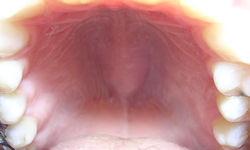Palatine raphe
| Palatine raphe | |
|---|---|
 Palate exhibiting torus palatinus. (Raphe visible near center.) | |
| Details | |
| Identifiers | |
| Latin | raphe palati |
| TA98 | A05.1.01.105 |
| TA2 | 2782 |
| FMA | 75111 |
| Anatomical terminology | |
The palatine raphe (also median palatine raphe[1]) is a raphe of the oral cavity. It is a narrow, slight midline ridge extending anteroposteriorly across the palate, from the incisive papilla anteriorly to the palatine uvula posteriorly.[2] Beneath the raphe, the submucosa is absent.[2][3]: 637
Anatomy
[edit]The palatine raphe is a midline tendinous band of the palate.[1]: 114
Relations and attachments
[edit]The raphe is a surface feature overlying - and indicating - the intermaxillary suture, and median palatine suture.[1]: 114-115
The greater palatine foramen may be palpated on either side about half way between the palatine raphe, and the palatal gingival margin of the 2nd or 3rd upper molar tooth.[1]: 59, 220
The palatine raphe serves as an attachment for multple muscles: the palatoglossus muscle arises from the posterior portion of the raphe; the levator veli palatini muscle and (the tendon of) the tensor veli palatini muscle insert into the raphe.[1]: 114-115
References
[edit]- ^ a b c d e Fehrenbach, Margaret J.; Herring, Susan W. (2017). Illustrated Anatomy of the Head and Neck (5th ed.). St. Louis: Elsevier. ISBN 978-0-323-39634-9.
- ^ a b Sinnatamby, Chummy S. (2011). Last's Anatomy (12th ed.). p. 380. ISBN 978-0-7295-3752-0.
- ^ Standring, Susan (2020). Gray's Anatomy: The Anatomical Basis of Clinical Practice (42th ed.). New York: Elsevier. ISBN 978-0-7020-7707-4. OCLC 1201341621.
External links
[edit]- "Anatomy diagram: 05287.011-1". Roche Lexicon - illustrated navigator. Elsevier. Archived from the original on 2013-04-22.
- Diagram at bris.ac.uk
- Diagram at ana.bris.ac.uk
- Diagram at waybuilder.net
